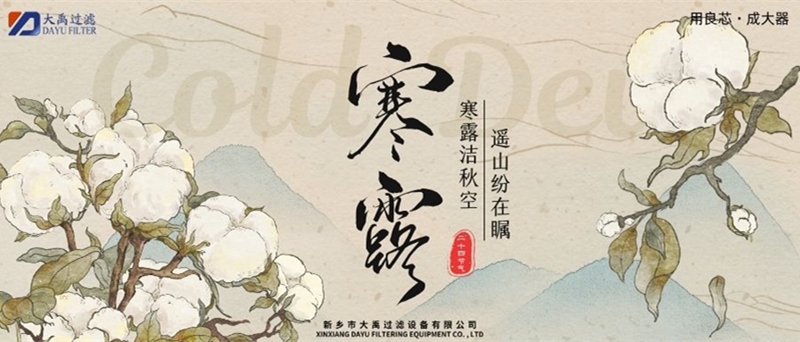Autumn deepens, dew grows heavy, Poetic golden autumn.
Cold Dew is the seventeenth solar term in the traditional Chinese calendar and the fifth solar term of autumn, typically occurring between October 7th and 9th each year. In northern regions, cold air masses intensify, causing a significant widening of the temperature gap between day and night. Morning dew condenses more heavily due to the chill, giving rise to the phenological characteristic of “cold dew, about to freeze.” As the beginning of the lunar month of Xu in the sexagenary cycle, Cold Dew not only marks a climatic turning point but also carries rich cultural connotations and agricultural wisdom.
Climate Characteristics and Natural Phenology
During Cold Dew, autumn deepens in the south, bringing crisp, cool air with little rain and dry conditions. In the north, early winter scenes emerge, with frost blanketing vast areas in the northeast and northwest, forming a stark contrast to the southern autumn hues. The Yuan Dynasty text “Collected Explanations of the Seventy-Two Solar Terms” divides Cold Dew into three phases: First Phase: Wild geese arrive as guests, marking the final southward migration of wild geese. Second Phase: Sparrows enter the great waters and become clams, as ancient observers imagined birds transforming into clams when sparrows vanished and coastal clams proliferated. Third Phase: Chrysanthemums bloom with yellow flowers, symbolizing late autumn as they flourish amid the gathering yin energy. At this time, the temperature difference between day and night can exceed 10°C. While mornings bring heavy dew and days offer crisp, clear autumn weather, nighttime temperatures plummet sharply. Caution is advised against “cold entering through the feet,” as reflected in the folk saying: “At White Dew, keep your body covered; at Cold Dew, keep your feet covered.”
Traditional Customs and Cultural Heritage
Cold Dew customs blend natural observation with practical wisdom. Beijing's Fragrant Hills offer peak autumn foliage viewing during Cold Dew, drawing crowds to experience the poetic scene of “frosted leaves redder than flowers in February.” In southern China, “autumn fishing by the shore” becomes popular as cooler temperatures drive fish toward shallower waters, increasing catch rates. Another folk custom involves eating sesame seeds during Cold Dew—used for oil extraction and pastries—which nourish yin and alleviate dryness. As chrysanthemums bloom, drinking chrysanthemum tea and savoring chrysanthemum wine become fashionable. The Double Ninth Festival often coincides with Cold Dew, forming the “Chrysanthemum Month” culture. Additionally, activities like eating female crabs, admiring chrysanthemums, and mountain climbing all reflect the ancient people's harmony with the seasons and their refined enjoyment of autumn.
Health Preservation Wisdom and Agricultural Guidance
Cold Dew health preservation emphasizes “nourishing yin in autumn and winter.” Diet should nourish yin and moisturize dryness, favoring sesame seeds, walnuts, white fungus, pears, and lotus roots while minimizing spicy and greasy foods. Daily routines should involve early sleep and rising to align with the expansion of yang energy. Exercise should be gentle, such as walking or tai chi, avoiding excessive sweating that depletes energy. Keeping feet warm is crucial; hot foot baths can promote blood circulation. For farming, northern regions should expedite winter wheat sowing, while southern areas must rush to harvest late rice and sow rapeseed, guarding against cold damage to rice from the “Cold Dew Wind.” South China may experience prolonged drizzles, necessitating swift harvesting and sowing during sunny intervals to ensure progress in the “three autumn tasks.”
The Aesthetic of Cold Dew in Poetry
Literary figures throughout history often captured Cold Dew in verse to express autumnal reflections. Bai Juyi's “By the Pond” captures autumn's desolation: “A cool breeze stirs gently, cold dew falls sadly.” Yuan Zhen's “Ode to the Twenty-Four Solar Terms” portrays chrysanthemums in full bloom: “Cold dew startles autumn's late arrival; morning reveals chrysanthemums turning yellow.” Wang Anshi's verse conveys autumn night's solitude: “In the empty courtyard, autumn stretches endlessly; cold dew falls at dusk, making thin clothes feel thin.” These verses not only chronicle seasonal phenomena but have become quintessential imagery for “autumn musings” in Chinese culture.
Modern Significance and Ecological Insights
In contemporary times, the wisdom of Cold Dew remains instructive. Climatologically, it alerts people to the health impacts of sudden temperature drops; ecologically, phenological phenomena like chrysanthemums and red leaves serve as vivid teaching materials for nature education; culturally, preserving Cold Dew customs strengthens national identity. In the face of climate change, Cold Dew's philosophy of “adaptation and harmony” grows ever more precious—aligning with nature's rhythms while achieving harmonious coexistence through scientific management (such as agricultural adjustments and health preservation).
Cold Dew marks autumn's finale and winter's prelude. With dew as its brush and wind as its ink, it writes seasonal poems across the heavens and earth, embodying both the wisdom of agrarian civilization and the Chinese people's profound understanding of natural cycles and pursuit of poetic dwelling. In this season of deep autumn and heavy dew, slow down your pace, admire a crimson maple leaf, savor a cup of chrysanthemum tea, and embrace the tranquility and abundance brought by Cold Dew.




